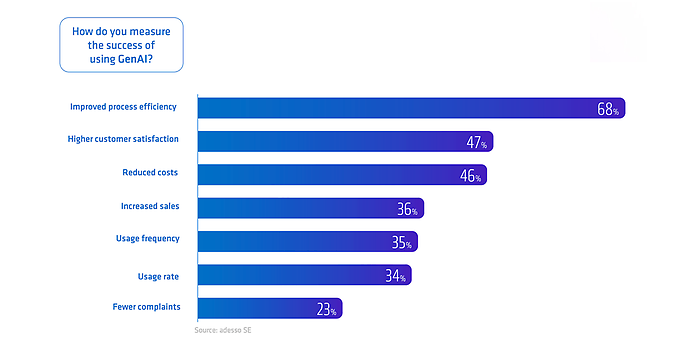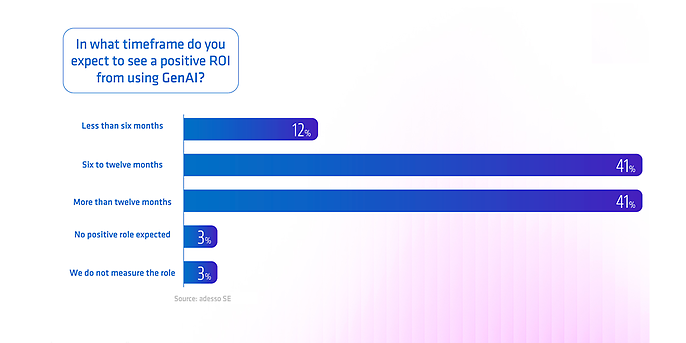28. July 2025 By Niklas Langner
From hype to impact: How GenAI is truly transforming businesses
The hype around Generative AI (GenAI) has hit German companies – and with it, a tsunami of tools, pilots and strategies. What was experimental yesterday is now everyday life: over 30% of German executives use GenAI on a daily basis – and the trend is rising. But despite this momentum, the key question remains: do these applications generate measurable, sustainable value?
GenAI in practice: between potential and pragmatism
In many German companies, the use of generative AI is currently still in an exploratory phase. Studies show that GenAI is currently used primarily as a smart everyday helper – for example, for text generation, idea collection or research. The technological potential is recognised, but remains limited to isolated use cases and has rarely been scaled strategically.
Instead of visionary breakthroughs, classic goals such as efficiency and cost savings currently dominate. In our GenAI Impact Report Germany 2025, 68 percent of companies stated that they use GenAI for process optimisation. 47 percent are pursuing an improved customer experience, while 46 percent cite cost reduction as their central goal.
This clearly shows that generative AI is currently being used primarily as a tool to increase the efficiency of existing structures. Its far greater potential as a driver of innovation, new business models or revenue growth remains untapped in many areas.

Practical example: BayernLB – from email overload to process intelligence
A specific application example shows what is possible: Bayerische Landesbank was facing a typical challenge in the banking sector: over 2,000 emails per day in credit management alone – each of which had to be read, classified and processed manually.This was time-consuming, error-prone and not scalable.
Together with adesso, BayernLB developed a GenAI-based application on Microsoft Azure OpenAI that automates the entire process: emails are analysed, attachments are evaluated using natural language processing, relevant data is extracted and automatically stored in the CRM in a structured manner. This results in accurate orders – without manual processing.
The result: significant efficiency gains, higher data quality and more freedom for value-adding tasks. This is a concrete example of how GenAI not only optimises processes, but also enables real transformation in everyday business.
We support you!
Ready to use GenAI strategically? Whether you're looking to launch initial pilot projects or scaled platform solutions, we can help you integrate Generative AI into your business processes. Our experts will show you how to turn technology into real added value.
GenAI is more than a tool – it is a driver of transformation
Whether text, code, images or analyses – GenAI generates content in seconds. The technology is already being used for automated customer communication, more efficient software development and intelligent document processing.
However, many initiatives remain isolated, often confined to innovation or IT departments.
The result: impressive prototypes – but no sustainable business value.
Yet expectations are high: the GenAI Trend Report shows that more than half of companies (53 percent) expect a measurable return on investment (ROI) in the first year after introducing generative AI.
At the same time, expectations are high: according to the GenAI Trend Report, 53% of companies expect a measurable return on investment in the first year after implementation. However, this expectation often collides with reality: lack of data strategy, no scaled infrastructure, insufficient operational integration.

Three levers for real business impact
If you want to create real value with GenAI, you need more than just good ideas – you need a structured, holistic approach. Three levers are crucial:
1. Use cases with substance instead of gimmicks
The decisive difference lies in the depth of integration: While many companies start with general applications such as chatbots, GenAI only unleashes its full potential in deeply embedded, process-specific use cases – such as automated contract review in the legal department, AI-supported quotation creation in sales or intelligent onboarding in HR.
Tip: Identify recurring, data-driven processes with high volumes and high effort – this is where GenAI has the greatest impact.
2. Data strategy as the foundation
Without high-quality, contextually relevant data, any AI model is blind. According to a study, 68% of companies are confident that they can prepare their data, but only 22% currently consider it truly suitable for secure, effective GenAI integration.
A powerful GenAI approach requires:
- Clear data governance
- Access to structured and unstructured data
- Protection of sensitive information (data protection, copyright)
In short: no impact without a clean database.
3. Operation & scaling: from pilot to platform
A successful proof of concept is only the beginning. Only when GenAI runs reliably in daily operations does real value emerge. Success factors are therefore:
- Integration into existing processes and systems
- Scalable infrastructure (cloud, APIs, ML Ops)
- Governance models for AI deployment (including responsibility, monitoring, ethics)
Important: Who operates GenAI? Who is responsible for the results? How is optimisation achieved? GenAI can only be scaled strategically with clearly defined operating structures.
German SMEs are at a crossroads
While some large companies are already pursuing dedicated GenAI strategies, many SMEs are still hesitant – often with good reason. Without clear goals, reliable data and structural integration, GenAI can quickly become a resource hog.
But those who take a structured approach now can secure a real competitive advantage. GenAI is not a short-term trend – it is a tool that allows entire business processes to be rethought
Conclusion: Think holistically, implement purposefully
The path from the initial idea to measurable success with GenAI leads through:
- 1. Clear business use cases,
- 2. a well-thought-out data strategyand
- 3. professional operation.
Only those who combine these building blocks will be able to use GenAI not just as a gimmick, but as a real driver of transformation.
What should companies do now?
GenAI is already changing business processes – making them faster, more efficient and more intelligent. Those who integrate the technology strategically will secure advantages in terms of time, quality and innovation.
Now is the right time:
- GenAI Readiness Check: A status quo analysis helps to clarify internal requirements – from data availability and IT infrastructure to regulatory requirements.
- End-to-end implementation: From identifying suitable use cases to integration into existing systems, GenAI should be thought out holistically and anchored in operations.
Companies that fail to strategically integrate GenAI at an early stage risk losing efficiency and competitive advantages in the long term – especially in markets where speed, scalability and automation are increasingly critical to success.
We support you!
Ready to use GenAI strategically? Whether you're looking to launch initial pilot projects or scaled platform solutions, we can help you integrate Generative AI into your business processes. Our experts will show you how to turn technology into real added value.

